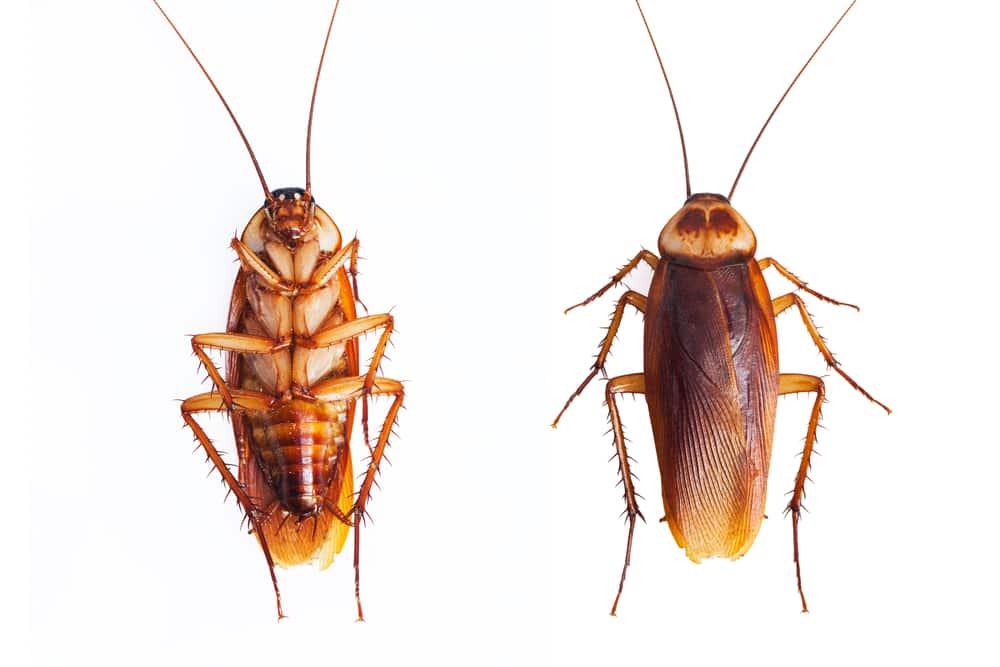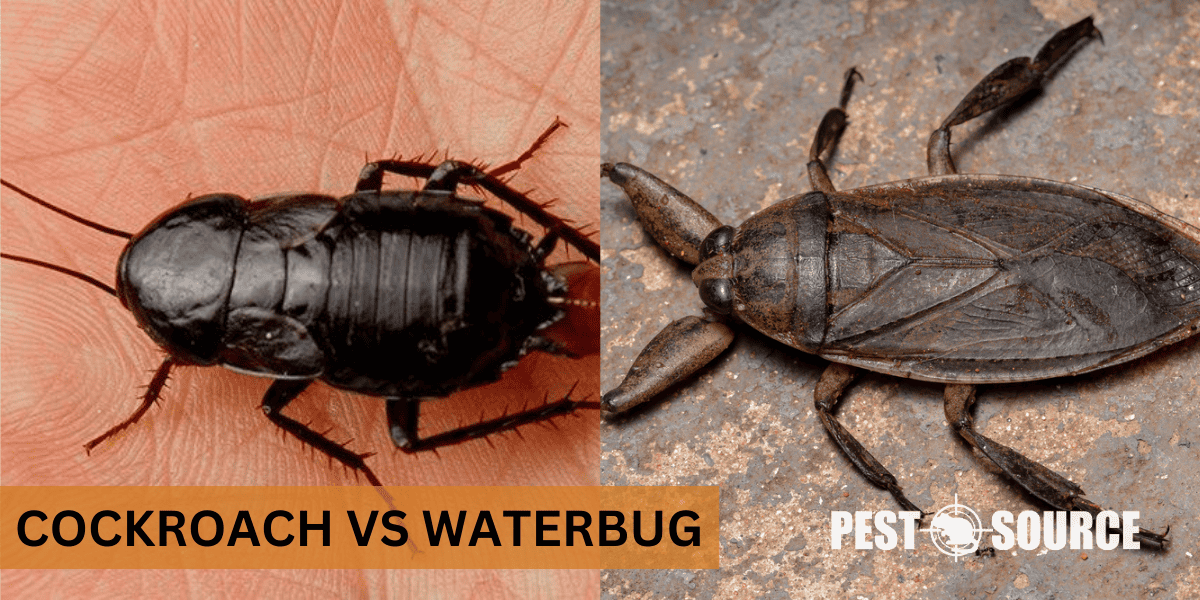Although “water bug” is frequently used interchangeably with cockroaches, true water bugs are a different type of insect. This guide highlights the key differences between these pests, including habitat and behavior, to help in proper identification and control.
POINTS
- Cockroaches and waterbugs can be differentiated by size, habitat, and behavior, with cockroaches being smaller, preferring dry environments, and commonly found indoors, while waterbugs are larger, aquatic, and more aggressive.
- Misidentification of cockroaches and waterbugs is common due to physical similarities and misuse of terms; for example, the Oriental cockroach is often incorrectly referred to as a waterbug.
- To control cockroach infestations, eliminate food and water sources, seal entry points, and consider using baits, traps, or professional pest control services.
- Waterbug control involves reducing standing water, maintaining pools and ponds, utilizing physical barriers, encouraging natural predators, and, if necessary, using chemical treatments with caution.
- Both cockroaches and waterbugs play significant ecological roles, with cockroaches acting as scavengers and waterbugs serving as predators in aquatic ecosystems; however, in urban settings, cockroaches are seen as pests due to health risks.
Cockroach vs. Waterbug: Understanding the Key Differences and Identifications
When it comes to household pests, it’s important to know your enemy. Often, people mistake cockroaches for waterbugs, or vice versa, which can lead to ineffective pest control methods. Understanding the key differences between these two pests is crucial for identification and proper elimination.
Physical Appearance, Habitat, and Behavior
Cockroaches

Cockroaches are one of the most common pests found in homes and businesses. They can be identified by their:
- Size: Common cockroaches are usually about 1.5 to 2 inches in length.
- Color: They are typically brown or reddish-brown.
- Body Shape: Cockroaches have a flattened oval body with a small head and six legs.
- Antennae: They possess long, flexible antennae.
Cockroaches prefer warm, humid environments and are often found in kitchens, bathrooms, and other areas where they can find food and water. They are nocturnal creatures and tend to hide during the day.
Waterbugs

On the other hand, waterbugs are a type of aquatic insect that are often mistaken for cockroaches due to their size and shape. Here’s how you can identify them:
- Size: Waterbugs can grow larger than cockroaches, with some species reaching up to 4 inches in length.
- Color: They are generally dark brown or black.
- Body Shape: Waterbugs have a flatter, wider body compared to cockroaches.
- Antennae: Their antennae are shorter and less noticeable than those of cockroaches.
Waterbugs are typically found in aquatic environments and are not commonly seen indoors unless they are searching for food or shelter. They are also known to be more aggressive than cockroaches and can deliver a painful bite.
Common Queries Addressed
- Difference between roach and waterbug: The main differences lie in their size, habitat, and behavior. Cockroaches are smaller, prefer dry environments, and are more common in human dwellings. Waterbugs are larger, aquatic, and less likely to be found indoors.
- Cockroach or waterbug: If you see a pest in your home that’s large and near water sources, it might be a waterbug. If it’s smaller and found in areas with food debris, it’s likely a cockroach.
- What is a water bug: A water bug is an aquatic insect that belongs to the order Hemiptera. They are predators and can live in pools, ponds, and other freshwater bodies.
- Common house water bug: While the term “water bug” can refer to several aquatic insects, in the context of pest control, it often refers to the Oriental cockroach, which is mistakenly called a water bug.
- Cockroach water bug: This term is a misnomer as cockroaches and waterbugs are distinct species, though they can appear similar to the untrained eye.
Water Bugs and Cockroaches: Common Misconceptions and Terminology Confusion
Misidentifying pests can lead to ineffective treatment strategies. Here, we’ll address common misconceptions and clarify the terminology confusion surrounding waterbugs and cockroaches.
Debunking Myths and Misconceptions
It’s a myth that all large, dark-colored bugs are cockroaches. While some cockroaches can be quite large, the giant waterbug, often called a “toe-biter,” is an entirely different species that lives primarily in water. Another misconception is that waterbugs are harmless. In truth, they can bite and are predatory by nature.
Why They Are Often Confused
The confusion often arises from the physical similarities between the two, such as their color and body shape. Additionally, the misuse of terms in everyday language contributes to this confusion. For example, the Oriental cockroach is frequently referred to as a “waterbug” due to its preference for damp areas, despite it being a true cockroach.

Tackling Queries
- Water bugs that look like cockroaches: This is usually referring to the Oriental cockroach, which has a similar appearance to aquatic bugs.
- Are water bugs roaches: No, water bugs are not roaches. They are different species with different habitats and behaviors.
- Waterbug or cockroach: To determine this, consider the environment where the bug was found. If it’s near water and quite large, it’s likely a waterbug. If it’s in a dry area indoors, it could be a cockroach.
- Black water bug: This term can refer to a large waterbug, such as the giant waterbug, or it could be a misidentification of a dark-colored cockroach.
Pest Control and Environmental Impact: Dealing with Waterbugs and Cockroaches
Effective pest control starts with understanding the behaviors and habitats of the pests you’re dealing with. While both waterbugs and cockroaches can be unwelcome guests, their differences necessitate distinct approaches to management and prevention.
Controlling and Preventing Infestations
Cockroach Control
Cockroaches are attracted to food, water, and shelter. To control and prevent cockroach infestations:
- Eliminate Food Sources: Keep your kitchen clean, store food in sealed containers, and dispose of garbage regularly.
- Remove Water Sources: Fix leaky faucets and pipes, and don’t leave standing water in sinks or buckets.
- Seal Entry Points: Caulk cracks and crevices, fix window screens, and use door sweeps to prevent cockroaches from entering.
- Use Baits and Traps: These can be effective in reducing cockroach populations when used correctly.
- Professional Pest Control: Sometimes, an infestation requires professional treatment to fully eradicate the pests.
Waterbug Control
Waterbug control focuses on outdoor environments:
- Reduce Standing Water: Eliminate standing water in your yard, such as in birdbaths, pots, and puddles, to discourage waterbug habitation.
- Maintain Pools and Ponds: Properly chlorinate swimming pools and maintain natural ponds to deter waterbugs.
- Physical Barriers: Use screens on windows and doors to prevent waterbugs from entering your home.
- Natural Predators: Encourage or introduce natural predators, like birds or frogs, to control waterbug populations.
- Chemical Treatments: In some cases, insecticides may be necessary, but they should be used with caution due to potential environmental impacts.
Environmental Impact and Ecological Significance
Cockroaches
Cockroaches play a role in the ecosystem by breaking down dead and decaying matter, thus recycling nutrients back into the soil. However, in urban environments, they are considered pests due to their potential to spread disease and cause allergic reactions.
Waterbugs
Waterbugs are important predators in aquatic ecosystems, helping to control populations of other insects and sometimes even small fish. They are an essential part of the food web, serving as prey for larger animals like birds and amphibians.
Addressing Queries
- Roach vs waterbug: The key to distinguishing between the two is understanding their environmental roles; cockroaches are scavengers, while waterbugs are predators.
- Water bugs roaches: This query highlights the common confusion. Remember, water bugs are not roaches; they are different species with different roles in their respective environments.
- Difference between water bugs and roaches: Water bugs are aquatic predators and play a different ecological role than roaches, which are terrestrial scavengers.
- Oriental water bug: This is a misnomer for the Oriental cockroach, which is a pest in human habitats but has a preference for damp areas.
By addressing these differences and implementing targeted control measures, we can manage pest populations effectively while minimizing our impact on the environment. Understanding the unique characteristics and ecological roles of waterbugs and cockroaches is essential for maintaining a balanced approach to pest control.
Cockroach vs. Bed Bug
Cockroaches and bed bugs, despite both being common household pests, have different habits and appearances. Bed bugs are small, wingless insects that feed exclusively on the blood of humans and animals, usually at night. They are known for their bites, which can cause itching and discomfort. Cockroaches, conversely, have a broader diet, feeding on a variety of organic materials, and are typically larger and have wings. While bed bugs are mainly found in bedrooms and places where people sleep, cockroaches can inhabit various parts of a home, particularly in kitchens and bathrooms.



